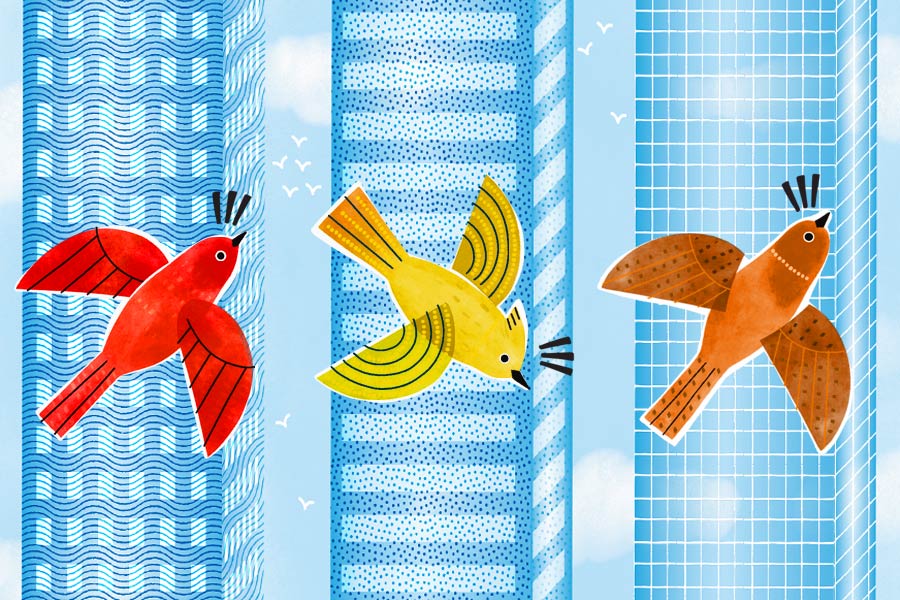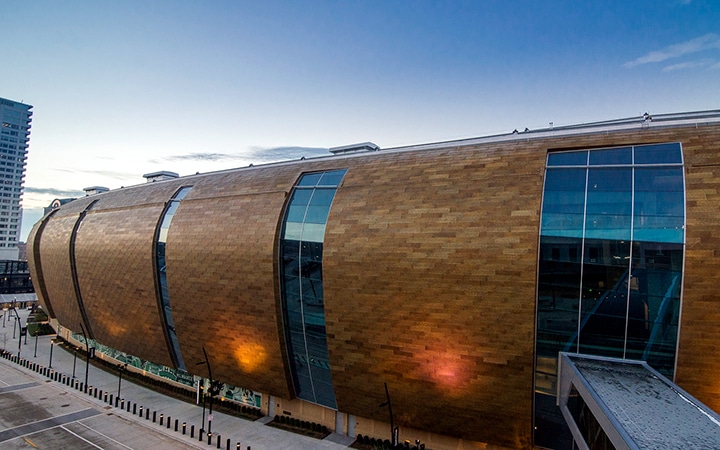Illustration by Lindsay Gruetzmacher
As the construction industry continues to improve its environmental sustainability, bird-friendly building design has become a critical juncture in the effort.
The National Basketball Association’s Milwaukee Bucks, for instance, play in a bird-friendly stadium, and skyscrapers featuring bird-repellent components such as textured metal surfaces or fritted glass have become an increasingly common sight, as municipalities like San Francisco and Toronto have adopted voluntary guidelines to encourage the construction of more bird-friendly structures.
Now, in a historic move that promises to shape the future of environmentally conscious building regulation, New York City has become the first major American municipality to pass a law requiring all new construction to be bird safe.
“The migratory birds on the East Coast run this gauntlet,” said Dr. Christine Sheppard, director of the Glass Collisions Program at the American Bird Conservancy. “If you look at a night view of the Eastern seaboard, it’s city all the way down.”
Migrating birds must contend with the skyscraper corridors of these urban areas, whose tall glass buildings blend seamlessly into the sky, resulting in what the Audubon Society estimates to be around 90,000 fatal bird collisions in New York alone each year. Sheppard and other conservationists hope that the new law will create a roadmap for bird-friendly construction, dramatically reducing annual fatalities.
What makes a building “bird-friendly?”
Even prior to the passage of the law, Sheppard said that a large number of accidentally bird-friendly buildings are already being constructed. “In 2011, we published the first edition of bird-friendly building design, and there were virtually no buildings in it that had been designed to be bird-friendly on purpose,” Sheppard said. “But I was able to lavishly illustrate that manuscript with buildings that were bird-friendly unintentionally—in some cases to control sunlight or in other cases due to security concerns.”
Sheppard discovered that many of the techniques used to create more energy efficient and secure structures, such as grillwork or metal facing, have the side benefit of offering more complexly textured surfaces, which birds are more readily able to perceive mid-flight.
Even if an architect wants to build a glass box, it’s easy to reduce collisions with the use of bird-friendly glass. “One really good example is the Jacob Javits Convention Center in Manhattan, a big glass building that used to be the leading bird killer in the city,” Sheppard said. “They re-did the glass, using a fritted glass sunshade with a pattern of ceramic dots that’s screened onto and then fired onto the glass so it’s visible to birds. It still looks like a giant glass building, and if you’re standing in it, you would never be able to see the pattern on the glass. And yet they’ve reduced bird collisions 90%.” An added bonus: The Javits Center has also dramatically reduced its HVAC costs.
Architect Kate Mann, associate principal at Ennead Architects, who was also the project designer for the bird-friendly Vassar Bridge Building, said that working with fritted glass can provide an opportunity for creativity.
“You’re trying to make the glass hyper-visible on one side, and on the other side you’re trying to make it invisible to the users,” Mann said. “We decided to take the opportunity to make this a design feature, creating a birch tree pattern abstracted into a series of horizontal lines. The use of fritting has a lot of positive energy and sustainability implications for glass—not just for bird visibility, but also for improved sustainability and heat control.”
The benefits of birds
Bird-friendly construction has lasting environmental and fiscal benefits for the humans who use these spaces.
Aside from a friendly concern for our feathered friends, Sheppard said that paying attention to the welfare of birds has a number of benefits. “Birds provide economic benefits to people that we’re generally just not aware of,” Sheppard said. “They provide hundreds of billions of dollars in economic services, like eating insects, including mosquitoes and pests like the Emerald Ash borer.”
There are also many crops that are pollinated by birds, who are especially critical in a time when bee populations are being impacted by colony collapse. “Birds provide immense service to agriculture,” Sheppard said, “especially if you’re growing organic.” Birds also reduce pests injurious to human life, like disease-spreading mosquitoes, which Sheppard said birds eat “by the pound.”
In addition to their usefulness as pollinators, birds are of critical importance to the growing population of American bird watchers. “Birdwatching is one of the fastest-growing industries,” Sheppard said. “It’s a $50 billion industry, with associated employment from people who run bed-and-breakfasts near nature reserves, people who sell camera equipment and binoculars, and many other segments of the industry.
‘You’re trying to make the glass hyper-visible on one side, and on the other side you’re trying to make it invisible to the users. We decided to take the opportunity to make this a design feature, creating a birch tree pattern abstracted into a series of horizontal lines.’
Kate Mann, associate principal at Ennead Architects
Right now, birdwatching and awareness of collisions are increasing, because people are stuck at home looking out the windows. A lot of people who always thought they didn’t have a collision problem are contacting us because suddenly they’re home when the birds are hitting the windows!”
This increasing awareness of collisions is a good thing—especially since the new law also covers single family homes. “Almost 50% of collisions happen on private homes,” said Sheppard, who added that it’s relatively easy to make your home bird-friendly, even if you’ve already installed standard glass. “All you need to do is put a nice insect screen, top to the bottom,” Sheppard said. “It’s really simple to make a bird friendly home.”
A more bird-friendly future
Sheppard believes that the new law will have a profound impact on the environmental future of New York City and the larger construction industry. “I think we’ll start seeing more birds locally,” Sheppard said. “People will see more nature.”
As the birds return to New York City, Sheppard said people can expect to see reduced rates of pests like mosquitos and an increase in bird pollinated fauna in urban parks and backyards. Sheppard hopes that the law will become more common throughout the U.S., with New York’s successful implementation serving as a case study.
“There are people working in Baltimore, Washington, D.C., and Atlanta,” Sheppard said. “These collisions happen everywhere. There’s a lot of interest in this, because people are really starting to realize that birds are important. We need birds. We just don’t know it.”












